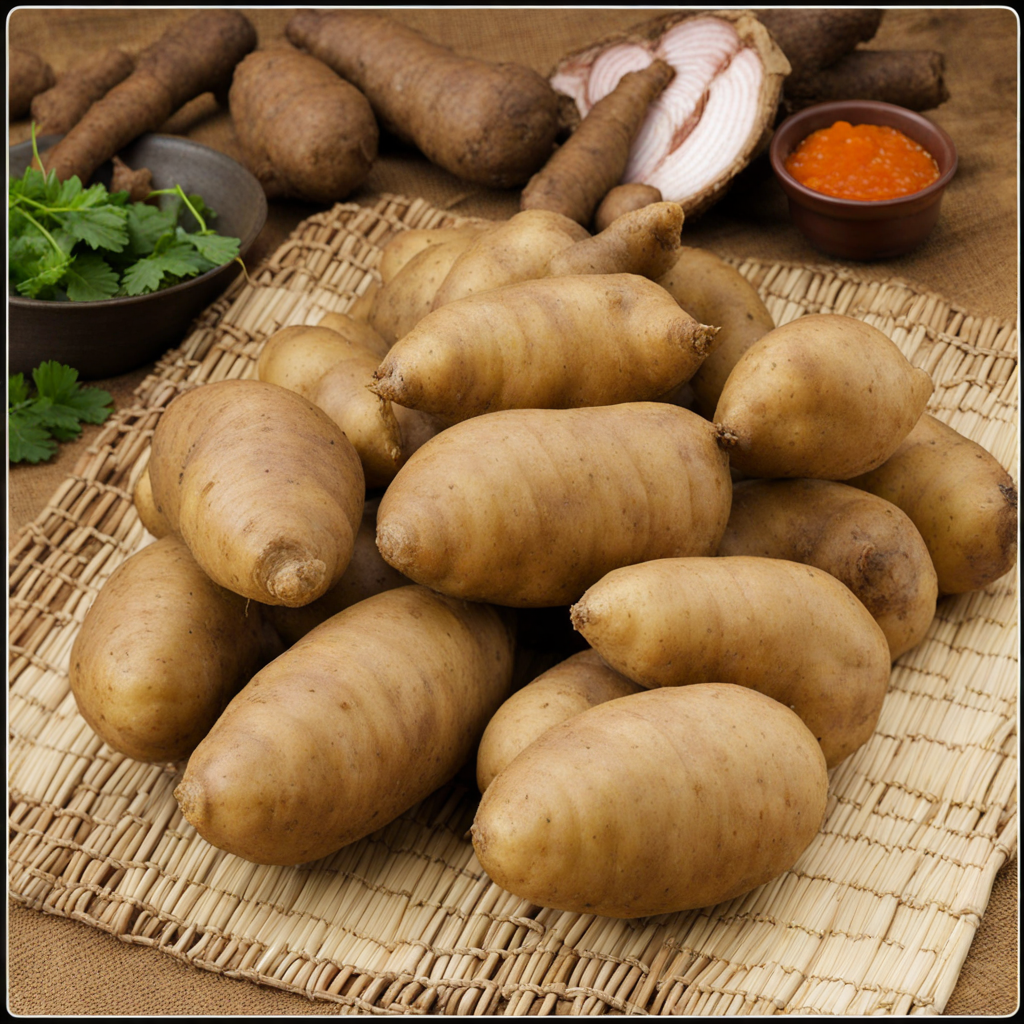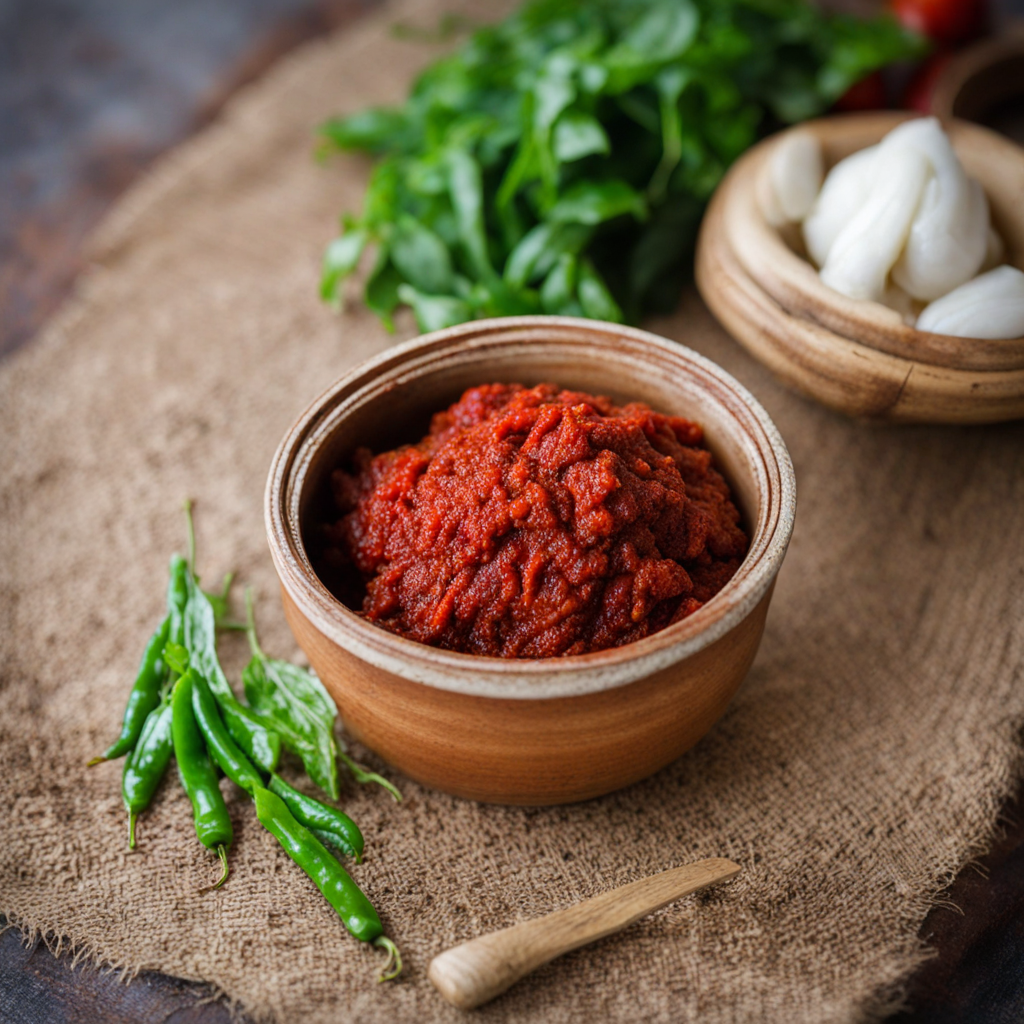Amateke
Amateke is a traditional Rwandan dish that showcases the country's rich agricultural heritage and the diverse flavors of its local ingredients. This dish primarily consists of ripe plantains, which are boiled or steamed until they reach a tender, silky texture. The natural sweetness of the plantains is complemented by a subtle hint of salt, creating a harmonious balance that is both comforting and satisfying. The vibrant yellow hue of the plantains, when served, adds an inviting visual appeal that beckons food lovers to indulge in its simplicity and authenticity. In Rwandan culture, Amateke is often enjoyed as a staple side dish, frequently accompanied by a variety of sauces or stews that enhance its flavor profile. These may include savory groundnut (peanut) sauce, which adds a rich, nutty depth, or a spicy tomato and onion sauce that brings a lively kick to the meal. The versatility of Amateke allows it to pair beautifully with diverse proteins, such as grilled meats, beans, or even leafy greens, making it a well-rounded option for any meal. Beyond its taste, Amateke embodies the essence of Rwandan communal dining, as it is often shared among family and friends during gatherings. The act of enjoying this dish together fosters a sense of connection and cultural pride, allowing diners to experience not only the flavors of Rwanda but also its warm hospitality. For those seeking to explore new culinary horizons, Amateke offers a delightful introduction to the flavors of East Africa and the unique culinary traditions of Rwanda.
How It Became This Dish
The History of Amateke: Rwanda's Culinary Treasure Amateke, commonly known as Rwandan edible fungus or mushroom, holds a significant place in Rwanda’s culinary heritage. This unique food item resonates deeply within the cultural fabric of the nation, symbolizing both sustenance and tradition. To understand Amateke is to delve into the rich history of Rwanda, exploring its origins, cultural significance, and the evolution of its consumption over the years. #### Origins of Amateke The history of Amateke can be traced back to the ancient practices of the Rwandan people who thrived in the Great Lakes region of Africa. The region's diverse ecosystems, characterized by mountainous terrains and lush forests, provided an ideal environment for various fungi to flourish. Rwandans, primarily the Tutsi and Hutu communities, recognized the nutritional value of these mushrooms long before formal agriculture took root. Traditionally, Amateke was foraged from the wild, with families passing down knowledge of mushroom hunting through generations. The indigenous knowledge surrounding the identification of edible mushrooms ensured that the community could distinguish between safe and toxic varieties. This practice not only contributed to food security but also fostered a deep connection to the land and its resources. #### Cultural Significance Amateke is more than just a food item; it embodies the spirit and resilience of the Rwandan people. In Rwandan culture, food is a central element of social cohesion, and mushrooms have often been associated with sharing and community gatherings. The act of foraging for Amateke was often a communal activity, bringing families and neighbors together, fostering bonds, and creating a sense of belonging. The preparation and consumption of Amateke are often linked to various cultural festivities and rites of passage. For instance, during harvest festivals, Amateke is prepared in diverse ways, showcasing its versatility. It can be sautéed, stewed, or incorporated into traditional dishes like ‘Isombe,’ a cassava leaf dish. The presence of Amateke during these celebrations underscores its role in symbolizing abundance and gratitude for nature's bounty. Moreover, Amateke has often been featured in Rwandan proverbs and folklore, emphasizing themes of cooperation and the importance of community. The mushroom’s growth—emerging from the earth seemingly overnight—has been likened to the resilience of the Rwandan people, who have thrived despite historical hardships. #### Development Over Time As Rwanda evolved, so did the significance and cultivation of Amateke. The colonial period brought profound changes to the Rwandan agricultural landscape, with traditional practices often overshadowed by introduced crops and farming techniques. However, the post-colonial era witnessed a revival of interest in indigenous food sources, including Amateke. In the late 20th century, particularly following the tragic events of the 1994 genocide, there emerged a renewed focus on food sovereignty and the importance of traditional foods. The Rwandan government, alongside various NGOs, began to promote the cultivation of indigenous crops and fungi as a means to restore agricultural practices and ensure food security. This movement was not just about sustenance; it was also a way to reclaim cultural identity and heritage. As a result, Amateke transitioned from being solely foraged to being cultivated more systematically. Agricultural programs initiated by the government and local organizations encouraged communities to cultivate mushroom farms, providing training on sustainable practices. This shift allowed for greater accessibility to Amateke and ensured that the knowledge of mushroom cultivation was passed on to younger generations. The introduction of modern agricultural techniques, coupled with traditional knowledge, has led to significant developments in mushroom farming. Farmers have learned to cultivate various species of edible mushrooms, including Amateke, which has led to increased production and commercialization. This evolution has not only enhanced food security but has also created economic opportunities for rural communities. #### Contemporary Relevance Today, Amateke stands at the confluence of tradition and modernity. It is celebrated in both rural and urban settings, and its presence is increasingly seen in local restaurants and markets. The Rwandan culinary scene is embracing Amateke, showcasing its versatility in contemporary dishes, from gourmet mushroom risottos to traditional stews. Furthermore, Amateke has gained recognition beyond Rwanda. As global interest in sustainable and indigenous food sources grows, Rwandan mushrooms have begun to attract attention from chefs and food enthusiasts worldwide. The narrative of Amateke as a symbol of resilience and cultural identity is being shared on international platforms, allowing Rwanda's rich culinary heritage to shine. #### Conclusion The journey of Amateke from wild foraged food to a symbol of cultural pride and economic opportunity exemplifies the resilience of the Rwandan people. Its roots in tradition, coupled with contemporary developments, reflect a dynamic food culture that honors the past while embracing the future. Amateke not only nourishes the body but also nourishes the spirit, reminding Rwandans of their rich heritage and the importance of community and connection to the land. As Rwanda continues to grow and evolve, Amateke remains a steadfast emblem of its culinary identity, a testament to the enduring power of food in shaping culture and community.
You may like
Discover local flavors from Rwanda







